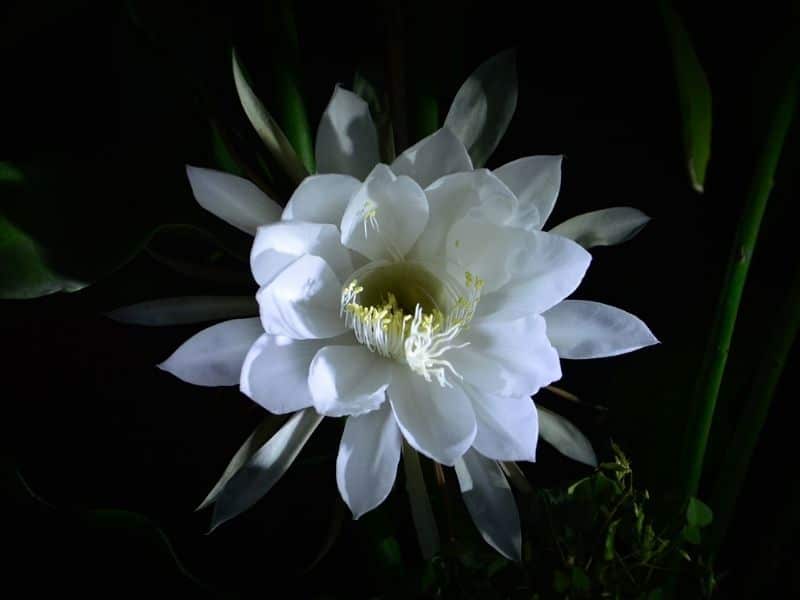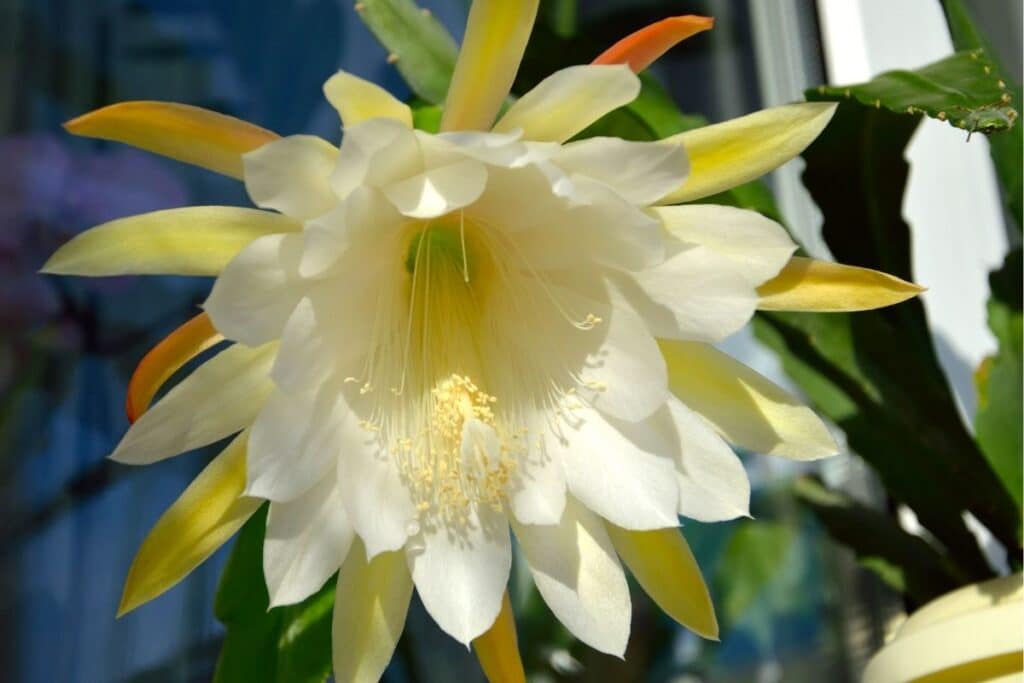When it comes to cacti, the stereotypical plump, ribbed, and spiny desert plants like the Ferocactus and Mammillaria come into mind that the thought of them growing on trees is quite bizarre.
However, there are types of cactus which not just grow on other plants but also look bushier and require less sunlight than most cacti. One of them is the spectacular Epiphyllum.
What is an Epiphyllum?
Epiphyllum is a genus of epiphytic cacti that grows on the surface of other plants obtaining food and moisture from the air and rain. The Greek word for “upon the leaf,” epiphyllum literally refers to the flowers borne on the plants’ foliage. They are also commonly called “leaf cacti” although technically, these are not leaves but specialized stems and branches that function as leaves (1).
The peculiar leaves of jungle cacti, such as those of the genus Epiphyllum, are a telltale sign of their identity.
They are native to the tropical rainforests of Mexico and Central and South America. While there are only 16 to 20 recorded epiphyllum species, there are over 13,000 hybrids showcasing a range of shape and form with fragrant flowers in almost every color too.
Established in 1813 by the English botanist, epiphyllums have flattened or triangular stems which conduct photosynthesis in the absence of leaves.

Unlike other cacti, orchid cactus stems are without spines and with reduced bristles. They form branches which droops. From the connecting points of these branches grow showy multi-petaled flowers, most bloom in the day, some bloom in the night.
The original epi species produce white flowers but through hybridization, more colors now exist. They look like and have the habit of orchids, hence the common name Orchid cactus. Most growers also call them by the nickname “epis” (1).
How to Care for and Orchid Cactus
Epis or Orchid cacti are popular hanging house plants for a reason. They are compact and profuse bloomers and do not require a lot of attention. They can easily adapt to varying indoor and outdoor conditions and are generally safe near pets and children.
Light and Water
Perched on other plants, often under the shade of tree canopies in the wild, epis are adapted to dappled light conditions. Unlike desert cacti which can withstand a long duration of full sunlight, they prefer partial shade. Howerver, too much light can cause your plant to wilt and yellow.
Full exposure from fall to early spring is beneficial to promote flower and strong growth.
Since they are capable of harnessing moisture from the atmosphere, manual watering should be moderate. Frequent misting is preferable just to keep the stems and aerial roots hydrated. As they naturally grow in organic materials on tree branches, their root system can tolerate adequate moisture all year round (2).
Temperature and Humidity
Orchid cacti can bear varying temperatures throughout the year, but before frost settles, they must be moved indoors. During winter, they can survive up to 50 °F (10 °C) but it is important to keep in mind that the potting soil should remain fairly dry to avoid winter damage and rotting of the plant. They need a rest during this period so cease watering for a month (3). The cooler, drier weather can encourage them to form flower buds.
These cacti are adapted to relatively higher humidity than their relative plants so during the height of summer, keep them near a water source or spray with water from time to time for proper hydration.
Pests and Diseases
Although they are not as fleshy as the common cactus, epiphyllums are still susceptible to mealybugs and spider mites attack. Their stem surfaces are broad and these pests can exist on both sides so vigilantly watch out for them (3). An infestation of fungus gnats may result from overwatering.
Application of diluted apple cider vinegar or rubbing alcohol by spraying is often an effective household remedy.
Propagating Epiphyllum and Maintenance
Orchid cacti reproduce with their own seeds. Breeders can easily produce hybrids by crossing one species to another and the resulting fruit called “apple” produces thousands of about 2 mm black seeds.
Each plant grown from seed takes up to 6 to 7 years before they mature and start producing flowers.
More conveniently, they can be propagated by stem cuttings. A stem can be removed from the mother plant and allowed to produce callus. Once it has healed, it is treated with a rooting hormone before planted into a loose, moist, and well draining potting mix (1).
Another popular way of growing epis among growers is by grafting upon the stem of a Pereskia. This produces established plants that can withstand strong winds when placed outdoors or even indoors and allows a better display of the drooping habit of the succulent stems (4).
Epiphyllums are used to growing in natural organic deposits on tree branches so potting them requires a loose and coarse organic soil mix. They will not tolerate a medium that retains too much water and gets compacted easily over a short period of time.
A recommended mix is made of equal parts coarse peat moss, coarse sand or perlite and cow manure with ½ part chopped charcoal and bone meal
Flowers appear in the summer or fall, and as soon as the first blooming period has passed, it is advisable to repot the plant to replenish the cactus soil nutrients and promote regular blooms. Moving forward, potting can be done every 2 to 3 years. Pot-bound plants may need regular applications of diluted liquid fertilizer during the growing season (2).
The Orchid cactus as a houseplant is often grown in hanging baskets to emphasize its fascinating drooping stems and a showy display of flowers during the blooming period.
Those grown in pots can benefit from staking and tying. This will provide support to the stems that tend to grow long and allow the individual branches to bloom in the years to come.
Best Orchid Cactus to Grow at Home
E. anguliger (Fishbone cactus)
This unusual orchid cactus has cascading wavy stems that look like fishbones, hence the common name. The night-blooming flowers are white and scented and turn into small edible green fruits with a taste similar to gooseberries.
E. oxypetalum (Queen of the Night cactus)
Queen of the Night is a night-blooming cactus native to Mexico and Brazil. The thin, flat stems can extend up to 20 ft (6 m) and are deeply round-toothed. The white flowers that grow as big as 10 in (25 cm) long are richly fragrant but often last for just one night.
Epiphyllum hybrid “Grace Ann”
This hybrid orchid cactus profusely produces big ruffled flowers that range from light to deep purple in color. These are borne on strong upright stems once they’ve grown about 4 ft (1.2 m) long.
E. phyllanthus (Climbing cactus)
This shorter species hails from Panama and Peru. The branches are oblong in shape and range from 1 ½ to 3 in wide. The flowers are white with pink hints at the center.
E. hookeri (Hooker’s orchid cactus)
One of the longer species native to the northern parts of South America, E. hookeri climbs up to 30 ft (9 m) high with its blunt-toothed stems. The 8 in long flowers also bloom at night and provide luminescence with their white color.
FAQs
Do orchid cactus only bloom at night?
Orchid cacti, such as Epiphyllum species, primarily bloom at night. The flowers often open in the evening and remain open through the night, withering by the next day.
How often do orchid cactus bloom?
Orchid cacti can bloom multiple times a year, typically during the spring and early summer. The frequency of blooming may vary depending on factors such as the plant’s age, health, and growing conditions.
Why is my orchid cactus not blooming?
Several factors can contribute to an orchid cactus not blooming, including insufficient light, inadequate nutrients, or stress from overwatering or underwatering. Ensure the plant receives proper care, including bright but indirect light or filtered light, regular fertilization during the growing season, and appropriate watering practices to encourage blooming.
Conclusion
You can grow Epiphyllum cacti as a fun and rewarding experience. These tropical succulents are easy to care for and can produce bright, large, fragrant, and night-blooming flowers in the spring or summer.
With the right care, they can grow up to 10 feet tall and showcase their beautiful blooms. So, if you’re looking for an easy-to-grow, slow-growing bathroom plant, Epiphyllum cacti are a great choice
References
Reference List:
(1) Euser, B. Gardening among Friends: 65 Practical Essays by Master Gardeners. 2005. Traveler’s Tales. P. 228.
(2) Everett, T. The New York Botanical Garden Illustrated Encyclopedia of Horticulture. 1980. Courier Corporation. P. 3601.
(3) Bailey, F. & Allaway, Z. Practical Cactus and Succulent Book. 2019. Penguin. P. 224.
(4) The Oregon Naturalist. 1891. University of Michigan. Iss. 1-7. P. 17.
Close
*image by igor.03.00.05.gmail.com/depositphotos







